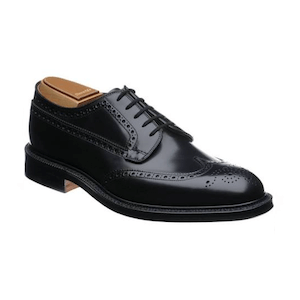
Goodwear welted shoes are constructed using a strip of leather or rubber (the welt), which runs around the perimeter of the leather upper. Stitching is then passed through the upper, welt and insole to attach the components.
As the outsole is attached using a completely separate stitch, the shoes can be easily re-soled and are extremely hard wearing. It's a labour intensive process, which means they're generally quite expensive but this a failsafe wardrobe investment.
Read on for our complete guide to Goodyear welted shoes, or use the links below to jump directly to each section:
- How To Recognise a Goodyear Welt Shoe
- The Best Brands For Welted Shoes
- How To Look After Welted Shoes
- Getting Goodyear Welted Shoes Re-soled
How To Recognise a Goodyear Welt Shoe
The Goodyear welt is named after Charles Goodyear Junior (son of the man the famous tyre company is named after) after he invented the machinery used to construct shoes using the process way back in 1869.
There are other construction methods for welted shoes (such as the less complex Blake welt), so how can you tell if you're buying the best quality Goodyear welted shoes?
Apart from reading the description of the shoes to check for references to the method used, the best way to tell the difference is to check that the stitching around the perimeter on the upper part of the outsole through the welt matches the stitching on the bottom of the outsole. The welt should also be visible around the perimeter of the leather upper and it sits on the top of the outsole.
Some shoe manufacturers add stitching purely for decorative reasons, so if in doubt ask directly if they are made using the Goodyear welt method and look closely at the construction.
The Best Goodyear Welted Shoe Brands
Most of the best Goodyear welted shoe manufacturers are based in Britain, specifically around Northampton, which has a long heritage of shoemaking. Below are some of the best British shoemakers for welted shoes so you know exactly where to invest when it comes to this gent's wardrobe staple…
Grenson
With a history dating back to 1866, Grenson has remained a stalwart supporter of British craftsmanship at its best. Each pair of Goodyear welted shoes that the firm produces take up to 8 weeks to craft in its Northamptonshire factory, involving over 200 different operations. The range extends across both shoes and boots, but the style to get your hands on is a pair of classic British brogues.Expect to pay: £210+ for welted Grenson brogues
Loake
Family owned and run shoemaker Loake has been crafting Goodyear welted shoes at the same factory in Kettering since 1894. Over 50 million pairs have passed through the factory during that time, making it one of the most experienced firms in the industry. The quality of the footwear produced by Loake led it to being granted a Royal Warrant of Appointment to HM The Queen in 2007, so you can confidently feel you're in good company by owning a pair of Loake shoes!Expect to pay: £199+ for Goodyear welted Oxfords or brogues
Cheaney
Launched by Joseph Cheaney in 1886, this Northamptonshire based shoemakers is committed to producing the finest footwear using traditional techniques. The range continues to grow and now extends across brogues, loafers, Oxfords, Derbys and Monk strap shoes – all of which feature a Goodyear welted leather sole. There's also an excellent refurbishment service provided by Cheaney, taking up to 6 weeks to rebuild the shoes to their original spec.Expect to pay: £325+ for Cheaney loafers, brogues or Oxfords
Jeffery West
Jeffery West is the new kid on the block within our round up of the best Goodyear welt brands, with the company only being launched in 1987. However, like others featured it's also based in Northamptonshire and still uses traditional methods. What helps to set Jeffery West apart are the designs seen across the range, with the company taking the Goodyear welt into the 21st Century. Expect to see the use of coloured leathers fused with statement detailing – these shoes aren't for any traditionalists among you!Expect to pay: £225+ for statement welted brogues or boots
Tricker's
Holding a Royal Warrant of Appointment to HRH The Prince of Wales, Tricker's is one of the oldest shoemakers in the business with a history dating back to 1829. Every pair of shoes you buy will have gone through 260 individual processes, from clickers judging the best direction to cut the leather in to craftsmen 'bunking' the soles. It goes without saying that all styles across the collection are constructed using the Goodyear welt method to ensure they last a lifetime (you'd hope so at the price!).Expect to pay: £375+ for suede or leather welted shoes
Church's
Run as a family firm from 1873, Church's was then bought by the Prada Group in 1999. This led to the introduction of more contemporary styles alongside the already established offerings, while retaining the traditional construction techniques. Although the range today extends across trainers and boat shoes, the majority of shoes are Goodyear constructed including the more colourful modern styles. Church's is quickly establishing itself as a heritage shoemaker pushing the boundaries in men's footwear.Expect to pay: £350+ for welted formal shoes
Edward Green
Edward Green has been crafting men's Goodyear welted shoes in its Northampton factory since 1890. Famed for being worn by the likes of Ernest Hemingway and the Duke of Windsor, its team of skilled shoemakers now produces over 300 pairs a week. These shoes definitely aren't cheap, but when you understand the processes involved (such as the soles being oak bark tanned for nine whole months), you quickly realise why. This really is Goodyear welted footwear at its best.Expect to pay: £900+ for Oxfords or semi-brogues
Barker
Founded by Arthur Barker in 1880, this iconic English brand has maintained the highest standard of shoemaking for over 135 years. The range today is extensive, covering everything from traditional monk strap shoes to highly polished Oxfords. For the more daring you'll also find styles offering a modern take on traditional classics by using two colours to produce a subtle colour contrast on the leather uppers.Expect to pay: £215+ for Goodyear welted dress shoes
George Cleverley
With Winston Churchill being known to have owned a pair of George Cleverley shoes himself, you know they must be good. The London-based shoemaker has gained a reputation for custom making shoes for the gentry, with each pair taking 90 man-hours to craft. Fortunately, the firm also now produces ready-to-wear Goodyear welted shoes that don't come with the bespoke price tag. And now for the best part - they're also handmade at the shoemakers London workshop.Expect to pay: £495+ for ready to wear shoes
Crockett & Jones
Crockett & Jones is the third Royal Warrant holder in our list and like Tricker's it's by appointment to HRH The Price of Wales. Founded in Northampton back in 1879, it has become renowned for its manufacture of Goodyear welted footwear. Generations of the founding family still run it to this day with the same ethos of focusing on quality and timeless style above anything else. These shoes really are a wardrobe investment that'll never disappoint!Expect to pay: £385+ for traditional Goodyear welt shoes
How To Look After Welted Shoes
Goodyear welted shoes are typically made using the finest materials and should last for years if you care for them properly.
Generally you should look after them in the same way as other quality shoes in your collection, using a leather cream regularly to keep the leather uppers supple and prevent them from cracking.
Using wax polish on top will provide an extra layer of protection against the elements, as well as adding some much important shine when you're needing to look your best.
If the welted shoes do get excessively wet for any reason, allow them to dry naturally away from any heat source. It's also best to stuff them with newspaper to aid the drying process.
When the shoes aren't in use for a period of time (as little as a week) it's a good idea to use a wooden shoe tree to help retain their shape. Likewise, use a shoe horn when putting them on to keep the backs of the leather uppers looking in prime condition.
Getting Welted Shoes Re-soled
Due to the design of the Goodyear welt, the soles can be replaced for a new pair to prolong the overall life of the shoes.
Most have a cork lining and you should get the welted shoes re-soled as soon as you see signs of the leather outer soles wearing through to this lining.
The cheapest way to get it done is usually at a local shoe repair shop such as Timpson, who offer a specific repair for the re-welting of Goodyear welted shoes.
Alternatively, most premium shoemakers like Loake offer a repair service to re-sole the shoes as well as refurbishing the uppers so the shoes look as new as they're going to. Expect to pay upwards of £80 for a full refurbishment of your Goodyear welted shoes.














